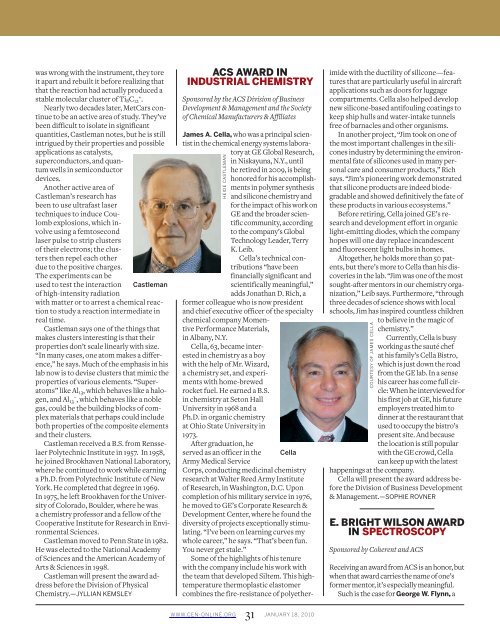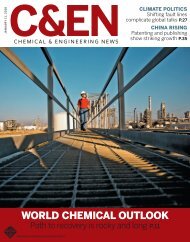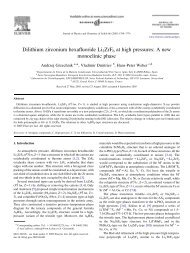Chemical & Engineering News Digital Edition - January 18, 2010
Chemical & Engineering News Digital Edition - January 18, 2010
Chemical & Engineering News Digital Edition - January 18, 2010
Create successful ePaper yourself
Turn your PDF publications into a flip-book with our unique Google optimized e-Paper software.
was wrong with the instrument, they tore<br />
it apart and rebuilt it before realizing that<br />
that the reaction had actually produced a<br />
stable molecular cluster of Ti 8 C 12 + .<br />
Nearly two decades later, MetCars continue<br />
to be an active area of study. They’ve<br />
been difficult to isolate in significant<br />
quantities, Castleman notes, but he is still<br />
intrigued by their properties and possible<br />
applications as catalysts,<br />
superconductors, and quantum<br />
wells in semiconductor<br />
devices.<br />
Another active area of<br />
Castleman’s research has<br />
been to use ultrafast laser<br />
techniques to induce Coulomb<br />
explosions, which involve<br />
using a femtosecond<br />
laser pulse to strip clusters<br />
of their electrons; the clusters<br />
then repel each other<br />
due to the positive charges.<br />
The experiments can be<br />
used to test the interaction Castleman<br />
of high-intensity radiation<br />
with matter or to arrest a chemical reaction<br />
to study a reaction intermediate in<br />
real time.<br />
Castleman says one of the things that<br />
makes clusters interesting is that their<br />
properties don’t scale linearly with size.<br />
“In many cases, one atom makes a differ-<br />
ence,” he says. Much of the emphasis in his<br />
lab now is to devise clusters that mimic the<br />
properties of various elements. “Superatoms”<br />
like Al 13 , which behaves like a halogen,<br />
and Al 13 – , which behaves like a noble<br />
gas, could be the building blocks of complex<br />
materials that perhaps could include<br />
both properties of the composite elements<br />
and their clusters.<br />
Castleman received a B.S. from Rensselaer<br />
Polytechnic Institute in 1957. In 1958,<br />
he joined Brookhaven National Laboratory,<br />
where he continued to work while earning<br />
a Ph.D. from Polytechnic Institute of New<br />
York. He completed that degree in 1969.<br />
In 1975, he left Brookhaven for the University<br />
of Colorado, Boulder, where he was<br />
a chemistry professor and a fellow of the<br />
Cooperative Institute for Research in Environmental<br />
Sciences.<br />
Castleman moved to Penn State in 1982.<br />
He was elected to the National Academy<br />
of Sciences and the American Academy of<br />
Arts & Sciences in 1998.<br />
Castleman will present the award address<br />
before the Division of Physical<br />
Chemistry.—JYLLIAN KEMSLEY<br />
ACS AWARD IN<br />
INDUSTRIAL CHEMISTRY<br />
Sponsored by the ACS Division of Business<br />
Development & Management and the Society<br />
of <strong>Chemical</strong> Manufacturers & Affiliates<br />
James A. Cella, who was a principal scientist<br />
in the chemical energy systems laboratory<br />
at GE Global Research,<br />
in Niskayuna, N.Y., until<br />
he retired in 2009, is being<br />
honored for his accomplish-<br />
HEIDE CASTLEMAN<br />
ments in polymer synthesis<br />
and silicone chemistry and<br />
for the impact of his work on<br />
GE and the broader scientific<br />
community, according<br />
to the company’s Global<br />
Technology Leader, Terry<br />
K. Leib.<br />
Cella’s technical contributions<br />
“have been<br />
financially significant and<br />
scientifically meaningful,”<br />
adds Jonathan D. Rich, a<br />
former colleague who is now president<br />
and chief executive officer of the specialty<br />
chemical company Momentive<br />
Performance Materials,<br />
in Albany, N.Y.<br />
Cella, 63, became interested<br />
in chemistry as a boy<br />
with the help of Mr. Wizard,<br />
a chemistry set, and experiments<br />
with home-brewed<br />
rocket fuel. He earned a B.S.<br />
in chemistry at Seton Hall<br />
University in 1968 and a<br />
Ph.D. in organic chemistry<br />
at Ohio State University in<br />
1973.<br />
After graduation, he<br />
served as an officer in the<br />
Army Medical Service<br />
Cella<br />
Corps, conducting medicinal chemistry<br />
research at Walter Reed Army Institute<br />
of Research, in Washington, D.C. Upon<br />
completion of his military service in 1976,<br />
he moved to GE’s Corporate Research &<br />
Development Center, where he found the<br />
diversity of projects exceptionally stimulating.<br />
“I’ve been on learning curves my<br />
whole career,” he says. “That’s been fun.<br />
You never get stale.”<br />
Some of the highlights of his tenure<br />
with the company include his work with<br />
the team that developed Siltem. This hightemperature<br />
thermoplastic elastomer<br />
combines the fire-resistance of polyether-<br />
WWW.CEN-ONLINE.ORG 31 JANUARY <strong>18</strong>, <strong>2010</strong><br />
imide with the ductility of silicone—features<br />
that are particularly useful in aircraft<br />
applications such as doors for luggage<br />
compartments. Cella also helped develop<br />
new silicone-based antifouling coatings to<br />
keep ship hulls and water-intake tunnels<br />
free of barnacles and other organisms.<br />
In another project, “Jim took on one of<br />
the most important challenges in the silicones<br />
industry by determining the environmental<br />
fate of silicones used in many personal<br />
care and consumer products,” Rich<br />
says. “Jim’s pioneering work demonstrated<br />
that silicone products are indeed biodegradable<br />
and showed definitively the fate of<br />
these products in various ecosystems.”<br />
Before retiring, Cella joined GE’s research<br />
and development effort in organic<br />
light-emitting diodes, which the company<br />
hopes will one day replace incandescent<br />
and fluorescent light bulbs in homes.<br />
Altogether, he holds more than 50 patents,<br />
but there’s more to Cella than his discoveries<br />
in the lab. “Jim was one of the most<br />
sought-after mentors in our chemistry organization,”<br />
Leib says. Furthermore, “through<br />
three decades of science shows with local<br />
schools, Jim has inspired countless children<br />
to believe in the magic of<br />
chemistry.”<br />
Currently, Cella is busy<br />
working as the sauté chef<br />
at his family’s Cella Bistro,<br />
which is just down the road<br />
from the GE lab. In a sense<br />
his career has come full circle:<br />
When he interviewed for<br />
his first job at GE, his future<br />
employers treated him to<br />
dinner at the restaurant that<br />
used to occupy the bistro’s<br />
present site. And because<br />
the location is still popular<br />
with the GE crowd, Cella<br />
can keep up with the latest<br />
happenings at the company.<br />
Cella will present the award address before<br />
the Division of Business Development<br />
& Management.—SOPHIE ROVNER<br />
COURTESY OF JAMES CELLA<br />
E. BRIGHT WILSON AWARD<br />
IN SPECTROSCOPY<br />
Sponsored by Coherent and ACS<br />
Receiving an award from ACS is an honor, but<br />
when that award carries the name of one’s<br />
former mentor, it’s especially meaningful.<br />
Such is the case for George W. Flynn, a




